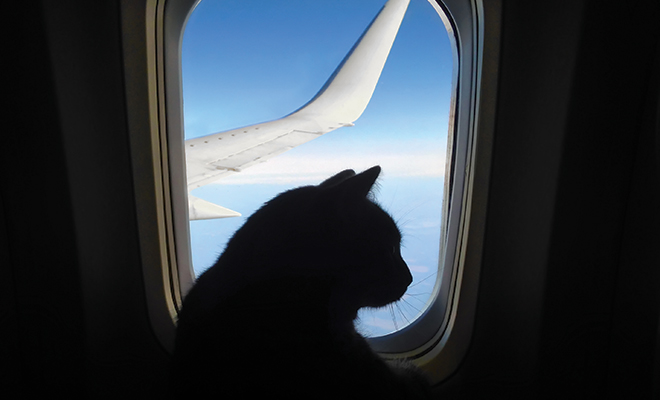
Air Pet: Flying with Your Fur Friends
When you go to the grocery store or the pet shop, does Blackie hop into the car? Does he stick his head out the window, thoroughly enjoying the wind in his face, or does he curl up on the seat and snooze away?
What’s the difference when flying? The animal will enjoy the flight, and you’ll both arrive safely at your destination. If you plan correctly, this scenario might happen, but planning is the key.
Safety
Three major tips will go a long way to ensuring your success in flying with your pet. First, always use direct flights. A dog experiences less stress with fewer stops. Second, always travel on the same flight as your pet. This way, you will be able to pick up your dog immediately after disembarking. Finally, when you board the plane, notify the captain and at least one flight attendant that your pet is traveling in the cargo hold. With today’s tighter security, this may not be possible. Even so, it’s better to advise the flight crew when possible to avoid unexpected surprises. Some airlines allow only cats and dogs; others also allow birds and rabbits.
Airlines have specific regulations concerning pets. In all cases, check with your carrier to be sure of their policies.
Temperature
Pets will not be carried if it is too cold or too hot during any leg of the flight. Some carriers restrict pet travel during specific months of the year and to certain destinations.
Health Certificates
When applicable, health certificates must be issued by a licensed veterinarian. The certificate will contain such information as general health of the animal, vaccinations, if the bitch is pregnant, if the pups are over ten weeks old and weaned, a vet’s signature and the date. Don’t try to avoid getting the certificate; what could be worse than being told you cannot ship your pet when you are ready to board? Remember, all airlines are independent and have their own regulations. Check with your carrier to be certain that you are in compliance with all their regulations.
Some carriers have prohibited the snub- or pug-nosed breeds from flying as checked baggage. These breeds are at risk when flying because they suffer from excessive heat and have problems with breathing. Carriers may permit them as onboard luggage.
International travel is a different ball game. Not only must you comply with the regulations of the airline carrier, you must be aware of the regulations of the country of destination. Many countries have stringent quarantine regulations to prevent the spread of rabies and other diseases of pets.
The International Air Transport Association regulations do not recommend sedating or tranquilizing pets for transport as it can be dangerous to their health. Drugs act differently at the pressure of 8,000 feet above sea level, which is the approximate air pressure in an aircraft during flight. Refer to the IATA website for further information on sedating animals during travel.
Many countries and carriers require pets be microchipped. At a minimum, make sure your pet’s identification tags are current.
Allergies
Passengers who are allergic to cats and other animals have few rights when flying with pets onboard. The pets can fly and passengers must deal with their problem. If the passenger makes his or her discomfort known, then the airlines will relocate the passenger if possible or reschedule the passenger’s flight.
Behavior
Try to relieve your pet’s travel anxiety by getting them used to the carrier or kennel before travel time. Place something familiar in the carrier such as an old towel or a favorite toy. You should have a first aid kit for emergencies in case of an accident during transportation. It might be a good idea to include a disposable pee pad in the kennel for the comfort of your pet.
Special Airline Carriers Dedicated to Pets
Flying commercial airlines can be difficult for both the pet owner and the pet. Charter jets might be a solution for you and your pets. Magellan Jets, Priority One Jets and others are designed to accommodate the needs of their passengers, both human and furry. Advantages include no standing in long TSA lines, schedules that meet your needs, no temperature and seasonal restrictions, no size or breed restrictions, no limit on the number of pets that can travel at one time, and menus for you and your pet that you choose.
The cost of private charters can run from several hundred dollars to several thousand for overseas travel. Consider traveling in a group, such as a pet holiday with friends, to reduce costs. Though prop planes take slightly longer, they are much less expensive than jets.
Whatever you decide, plan carefully so that you and your pet will enjoy the trip and arrive safely at your destination.
Sources: buypetmedicine.com, dogtravelcompany.net, magellanjets.com, pettravel.com, state.gov and usatoday.com.







